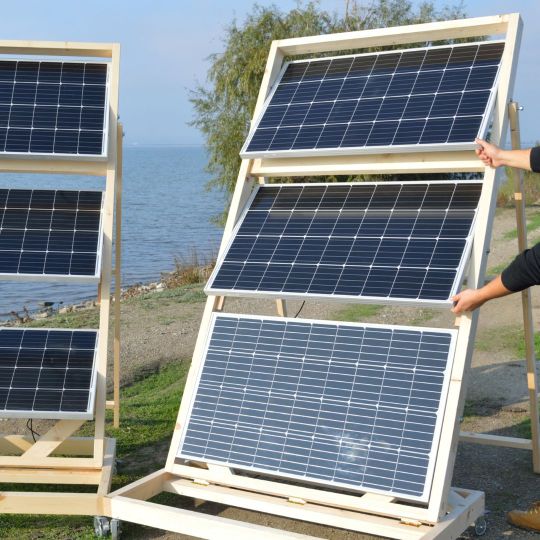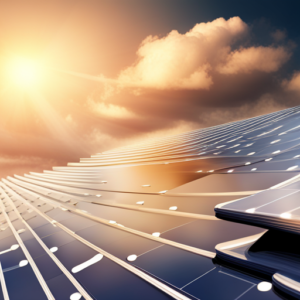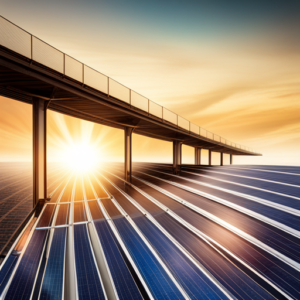#FutureofSolarEnergy
Text

Solar Switch Review | DIY Solar Panels | Discover the Space X of Solar Panels & 10x More Power
#solarswitchreview#solarswitchsystem#solarswitchorder#solarswitchbuy#solarswitchuk#ordersolarswitch#solarswitchbriankay#solarswitchusa#solarswitchprogram#solarswitchus#buysolarswitch#solarswitchpros#renewableenergytechnology#energyrenewable#renewableenergysolutions#100renewableenergy#renewableenergyprograms#renewableenergygenerator#futureofsolarenergy#greensolarenergy#solarenergystorage#solarenergyengineering
0 notes
Text
Solar Panel Efficiency: Solving the Puzzle of Solar Panels

Solar panels have become a symbol of optimism in the search for sustainable energy. These gadgets, seen on roofs and fields worldwide, can harness the sun's energy and turn it into electricity. And yet, how do they accomplish this feat? Why, then, are they only 20% effective? This tutorial will answer these questions and many more as it delves into the intriguing realm of solar panel efficiency. We'll delve into the research behind solar panels to learn more about how they work, what limits their efficiency, and where we could go from here. So, let's set out on an adventure to uncover the truth about solar panel efficiency.
An in-Depth Look at Solar Panel Efficiency

Solar Panel Efficiency
The Efficiency of Solar Panels: An Overview
The efficiency of a solar panel is its ability to convert energy from sunshine into a valuable form of energy. It's important because it affects how well and cheaply a solar power system works. A solar panel's efficiency indicates how much power it generates from a given quantity of sunshine. But what exactly does "20 percent efficiency" entail when applied to solar panels? This implies that the panel can only convert 20% of the sunlight falling on it into usable power, while the other 80% is either reflected or dissipated as heat.
How Solar Panels Work: The Science
Photovoltaics is the underlying technology behind solar panels. Semiconductor material, often silicon, in the solar panel soaks up the sun's rays. The silicon's electrons are jarred free as a result. The liberated electrons are collected and used to generate electricity. The quality of the semiconductor, the brightness of the sunlight, and the panel's orientation all contribute to the process's overall efficiency.
Exactly why do Solar Panels Only Produce a 20% Yield?
Science Behind Harnessing Solar Power
Semiconductor materials' physical features set a ceiling on solar panels' efficiency. The most prevalent material, silicon, is limited in the light wavelengths it absorbs. This implies that a significant fraction of the sunlight that strikes a silicon solar panel is either reflected or converted to heat rather than electricity. This is a significant factor in why the efficiency of solar panels is only about 20%.
The Efficiency of Solar Panels and it is Limiting Factors.
Other variables may lower a solar panel's efficiency in addition to the constraints of the semiconductor material. For instance, when temperatures rise, the efficiency of solar panels decreases. This is because a rise in temperature makes the semiconductor's electrons flow faster, making it more difficult to trap them and convert them into electricity. This is why solar panels are often positioned at an angle away from the roof for cooling. In addition to shade from trees and other buildings, dust and debris on the panel's surface may diminish efficiency by obstructing sunlight.
Does 100% Efficiency Exist for Solar Panels?

Does 100% Efficiency Exist For Solar Panels?
Efficiency of Solar Panels, Up to Their Thermodynamic Limit
The quick response is "No." The laws of thermodynamics limit the highest solar panel efficiency, which regulates energy conversion processes. This threshold, the Shockley-Queisser limit, is about 33 percent for solar panels made from silicon. A silicon solar panel can only convert roughly a third of the sunlight that reaches it into power, even under ideal circumstances.
Quantum Physics' Impact on Harvesting Solar Power
Quantum physics presents exciting potential for increasing solar panel efficiency beyond the thermodynamic limit.
There are some exciting prospects for increasing the efficiency of solar panels that may be gleaned from quantum physics. The efficiency of solar panels may be significantly improved, for instance, if they could use "multiple exciton generation" to produce many electrons from a single photon of light. However, more development of this technology is required before it can be used in a commercial setting, which might take many years or even decades.
The Quest for Greater Efficiency
The Increasing Effectiveness of Solar Panels Over Time
Technology and materials science improvements have led to a steady rise in solar panel efficiency. Panel efficiency was below 15% in the early days of solar electricity. Currently, available solar panels have an efficiency of above 22%. Improvements in solar cell design and manufacture, advancements in semiconductor materials, and new technologies like thin-film solar cells and concentrator photovoltaics have all contributed to this efficiency boost.
Improvements in technology have led to more efficient solar panels.
The efficiency of solar panels is rising thanks to many cutting-edge technological developments. New semiconductor materials like perovskite are being used, and "multi-junction" solar cells are being developed to absorb a broader light spectrum. Absorb as much of the sun's spectrum as possible, multi-junction solar cells are built using numerous layers of semiconductor materials. Consequently, they can generate more power from the sunlight on them.
Will Solar Panel Efficiency Increase to 30%?

Will Solar Panel Efficiency Increase To 30%?
Solar Panels with High Efficiency and Their Future
Multi-junction panels and those constructed from novel materials like perovskite have the potential to surpass the Shockley-Queisser limit, which establishes a theoretical maximum efficiency of roughly 33% for single-junction silicon-based solar panels. Within the next decade, according to some experts, solar panels with an efficiency of 30% or more may be accessible commercially. Achieving this efficiency level would be a huge step forward since it would lower the price of solar electricity and make it a more competitive option against fossil fuels.
Efficiency Improvements in Solar Panels: Recent Studies
A lot of study is being put into improving the efficiency of solar panels right now. Scientists and engineers from all around the globe are constantly exploring the limits of what is possible by trying out new materials, designs, and production methods. Perovskite solar cell development, nanotechnology for enhanced light absorption, and innovative solar cell layouts that can absorb more of the sunlight that falls on them are some of the most promising areas of study.
Which Solar Panels Have the Highest Efficiency?
The Efficiency of Solar Panels Breaks All Previous Records.
Researchers at the National Renewable Energy Laboratory (NREL) in the United States have produced a multi-junction solar cell with an efficiency of 39.2%, setting the current record for solar panel efficiency. However, this is just a record in the lab; commercial solar panels have yet to reach these levels of efficiency. Currently, the highest efficiency commercial solar panels on the market are approximately 22-23% efficient.
Efficiency Improvements in Solar Panels
Solar panels with ever-increasing efficiency as research proceeds and new technologies emerge. While perfect solar panels are theoretically impossible owing to physical constraints, the future of solar panel efficiency seems promising. Solar energy is becoming a more competitive energy source as efficiency continues to rise, and it might play a significant part in our energy future.
Solar Panels: Characteristics and Performance
Solar Panel Types: A Comparison
You may choose from many different solar panel styles, each with advantages and disadvantages.
Separate efficiency scores for each. Monocrystalline solar panels, typically black and have an efficiency of 15% to 20%, are now the most efficient form of solar panel commercially accessible. Polycrystalline solar panels are less expensive than monocrystalline panels despite their blue tint and somewhat lower efficiency. Thin-film solar panels are the most flexible and lightweight but have the lowest efficiency.
Comparison of Common Solar Panel Manufacturers' Efficiency
There is also a wide range of efficiency ratings across solar panel manufacturers. The most efficient solar panels on the market, with efficiencies of over 20%, are made by companies like SunPower and LG. Affordable alternatives with somewhat lower efficiency may be found from manufacturers like Canadian Solar and Trina Solar.
Influencing Factors on Solar Panel Performance
Temperature's Role on Solar Panel Performance
Since solar panels lose efficiency as their temperature rises, it is common practice to provide space between the panel and the roof so that hot air may escape. Especially in warmer locations, this temperature coefficient should be considered while selecting solar panels.
The Importance of Direct and Reflected Sunlight to Solar Energy Generation
The efficiency of solar panels is also affected by the amount of sunshine they receive and the direction from which it comes. When the sun is at its highest position in the sky and beaming directly onto the panels, it generates the most tremendous power. That's why many people in the Northern Hemisphere put solar panels on their south-facing roofs and the opposite in the southern hemisphere on their north-facing roofs. Solar tracking devices may be employed to boost efficiency further to shift the panels in the sun's direction throughout the day.
Improving the Performance of Solar Panels
Increasing Productivity Using Solar Trackers
Increase the efficiency of solar panels. Solar trackers are used to move the panels to track the sun as it travels across the sky. Solar trackers may be divided into two categories: those that follow the sun from east to west and tilt to keep up with the sun's arc across the sky. Although solar trackers may boost the efficiency of a solar power system by as much as 30%, they are also more costly and need more maintenance than permanently installed solar panels.
Effects of Anti-Reflection and Dual-Faced Designs
Bifacial designs may catch sunlight reflected off the ground onto the rear of the panel, further boosting efficiency. At the same time, anti-reflective coatings can assist solar panels in absorbing more sunlight and converting it into power. Anti-reflective coatings enable solar cells to absorb more light by decreasing the light reflected from their surfaces. However, bifacial solar panels can harness energy from direct sunlight and reflected light due to their double-sided light-absorbing construction.
Efficiency and Expense of Solar Panels
Cost-Effectiveness Analysis of Solar Panels
Solar panels with better efficiency may generate more power but at a higher cost. Therefore, it is essential to weigh whether or not the extra power produced by high-efficiency panels is worth the more excellent initial investment.
Do the Benefits of Greater Efficiency Always Justify the Price?
Over the panels' useful lifespan, the savings on power costs often exceed the initial investment in the more expensive high-efficiency solar panels. However, this is conditional on many variables, such as the price of power where you live and the quantity of sunshine available there. High-efficiency solar panels are a fantastic option for places with high power costs and plenty of sunshine.
How Efficiently Solar Panels Can Power Your House
What Effect Does the Efficiency of Your Solar Panels Have on You?
Your Monthly Electric Bill and the Performance of Your Solar Panels
The more power your solar panels can generate, the less you'll have to spend on your monthly energy bill. This is paramount if you reside in a region where power is expensive. By switching even a percentage of your energy use to solar power, you may save your annual electricity costs by hundreds, if not thousands, of dollars.
Which Solar Panels Are Best for Your House?
Before making a final purchase, you should weigh the solar panels' efficiency against their price, their lifespan, and the quantity of sunshine available where you live. You should consult a solar contractor to determine which panels work best for your home. They will evaluate your home's solar potential, determine the size of the solar power system you need, and provide product and brand recommendations based on your needs.
The Effects on the Planet of Inefficient Solar Panels
Solar Energy's Impact on Reducing Carbon Emissions
Solar panels may play a significant part in reducing the effects of climate change by turning sunlight into power without releasing greenhouse gases. The better the efficiency of the panels, the more power they can generate and the less of an impact they will have on the environment.
Improving Solar Panel Efficiency
and Its Impact on the Environment
Compared to less efficient panels, higher-efficiency solar panels generate more power from the same amount of sunshine, reducing your reliance on fossil fuels and overall carbon footprint. If you want to help the world fight to prevent climate change, one thing you can do is put high-efficiency solar panels on your house.
The Solar Panel Efficiency, Worldwide
Solar Energy's Impact on Securing Energy Self-Sufficiency
By harnessing the sun's energy, nations may lessen their reliance on foreign fossil fuel imports and strengthen their energy independence. The greater the efficiency of their solar panels, the more money they will save using solar energy.
The Importance of Solar Energy to the Economy and the Creation of New Jobs
The solar sector can contribute significantly to employment and economic growth. With the efficiency of solar panels increasing and the price of solar power decreasing, the solar energy sector is expected to continue expanding, creating new employment and economic stimulus for countries all over the globe.
Efficiency Improvements in Solar Panels

Improving The Performance Of Solar Panels
Perovskite Cells and Other Solar Energy Breakthroughs
The efficiency of solar panels might be significantly improved in the future with the help of new technologies like perovskite solar cells. There is much hope for the future of solar energy in the form of these technologies, which are still in the early phases of development.
The Future of Solar Power in the Next Decades
The efficiency of solar panels is expected to increase over the next several decades because of continued research and development. As it does, solar energy will play a more prominent role in our energy system, allowing us to cut emissions that contribute to global warming.
The Effectiveness of Solar Panels, Final Thoughts
While there is much to learn about solar panel efficiency, we must do so. The extent to which we can save money on our power bills, lessen our influence on the environment, and increase our energy independence depends on our solar panels' efficiency. Increasing solar panels' efficiency will be crucial to realizing solar power's full potential. It is reasonable to expect solar energy to assume an even more central position in our daily lives and the global economy in the not-too-distant future, thanks to the prospects offered by emerging technologies and the unrelenting pursuit of innovation.
Read the full article
#ClimateChangeMitigation#EnergyIndependence#FutureofSolarEnergy#Photovoltaics#RenewableEnergy#SolarEnergy#SolarIndustry#SolarPanelEfficiency#SolarPowerSystem#SolarTechnology
0 notes
Text
Perovskite Solar Cells: The Next Big Leap in Renewable Energy
Did you ever find yourself pondering on a sunny day how much energy we could harness if we effectively tapped into the sunlight bathing our planet? The answer: a lot! And, to reach this energy utopia, advancements in solar cell technology are key. One particular technology showing immense promise is the Perovskite Solar Cell. Read on to grasp why scientists and energy enthusiasts are buzzing about this!

What is Perovskite?
Brief history and origin
Don't get intimidated by the term "Perovskite" - it's just a type of mineral, first discovered in the Ural Mountains of Russia in the 19th century and named after the Russian mineralogist L.A. Perovski.
Unique properties
Perovskite, specifically the synthetic version used in solar cells, has a special crystallographic structure. This structure grants it fantastic light-absorbing properties and makes it a superstar in the world of photovoltaics.
What are Solar Cells?
How do they work?
Think of solar cells as tiny power factories. They convert sunlight into electricity using a process called the photovoltaic effect. When sunlight strikes the cell, it energizes the electrons, causing them to move and generate electricity.
Introduction to Perovskite Solar Cells
Understanding the mechanism
A Perovskite Solar Cell uses the unique properties of perovskite crystals to absorb sunlight and generate electricity. Just like a sandwich, the perovskite layer is nestled between other layers, each with a specific purpose, in order to create an efficient solar cell.
Advantages of Perovskite Solar Cells
Perovskite Solar Cells come with a host of benefits that are making traditional solar cells sweat:
Improved efficiency
Perovskite solar cells are giving traditional solar cells a run for their money, with lab efficiencies reaching over 25%. That's a major step up from the early days of perovskite cells, where efficiencies were only around 4%.
Lower cost
They're potentially cheaper to produce than their silicon counterparts. The reason? Perovskite can be manufacturedusing simple and inexpensive techniques, which is music to the ears of manufacturers and consumers alike.
Flexibility
Perovskite cells can be made flexible, lightweight, and semi-transparent, opening up possibilities for integrating them into buildings, vehicles, and even clothing.
Challenges and Solutions
Just like any budding technology, Perovskite Solar Cells are not without their growing pains. Here are some of the challenges they face:
Stability issues
These cells are not as long-lasting as traditional solar cells due to their sensitivity to moisture, heat, and UV light. However, researchers are continuously working on encapsulation techniques to protect the perovskite layer and enhance the cell's lifespan.
Toxicity concerns
The most efficient perovskite solar cells contain lead, raising toxicity concerns. Yet, don't worry! Scientists are actively exploring lead-free alternatives.
Current research trends
To address these challenges, intense research is ongoing globally, with scientists investigating new perovskite compositions, novel cell architectures, and advanced fabrication techniques.
Impact on the Renewable Energy Sector
With their potential, Perovskite Solar Cells are set to make waves in the renewable energy sector.
Potential market disruption
Due to their low cost and high efficiency, these solar cells could shake up the solar energy market, making solar power more affordable and accessible to the masses.
Future predictions
If current research trends continue, we could see a future where perovskite solar cells are common, not just in solar farms but in everyday products too.
Conclusion
Perovskite Solar Cells represent a significant leap forward in renewable energy technology. While there are challenges to overcome, the future looks bright for this innovative technology. It may not be too long before we see these high-performing, cost-effective solar cells helping to power our homes, cities, and possibly even our world.
Frequently Asked Questions (FAQs)
What is the efficiency of Perovskite Solar Cells?
Lab efficiencies of perovskite solar cells have reached over 25%. However, efficiencies can vary depending on the specific composition and structure of the cell.
Are Perovskite Solar Cells commercially available?
While significant strides have been made in research and development, commercial availability of perovskite solar cells is still limited due to issues like stability and lead toxicity.
Can Perovskite Solar Cells replace traditional silicon cells?
In the future, it's possible! With their high efficiency and lower potential cost, they present a compelling alternative to silicon cells.
Are Perovskite Solar Cells environmentally friendly?
The main environmental concern regarding perovskite solar cells is the use of lead in their composition. However, scientists are exploring lead-free alternatives to address this issue.
How long do Perovskite Solar Cells last?
Currently, their lifespan is not as long as traditional solar cells due to their sensitivity to certain environmental factors. But researchers are actively working to improve their stability and longevity.
Read the full article
#futureofsolarenergy#Low-CostSolarPower#PerovskiteResearchandDevelopment#PerovskiteSolarCells#RenewableEnergyTechnology#SolarCellEfficiency
0 notes
Text
youtube
Solar Switch Review | DIY Solar Panels | Discover the Space X of Solar Panels & 10x More Power
#solarswitchreview#solarswitchsystem#solarswitchorder#solarswitchbuy#solarswitchuk#ordersolarswitch#solarswitchbriankay#solarswitchusa#solarswitchprogram#solarswitchus#buysolarswitch#solarswitchpros#renewableenergytechnology#energyrenewable#renewableenergysolutions#100renewableenergy#renewableenergyprograms#renewableenergygenerator#futureofsolarenergy#greensolarenergy#solarenergystorage#solarenergyengineering#Youtube
0 notes